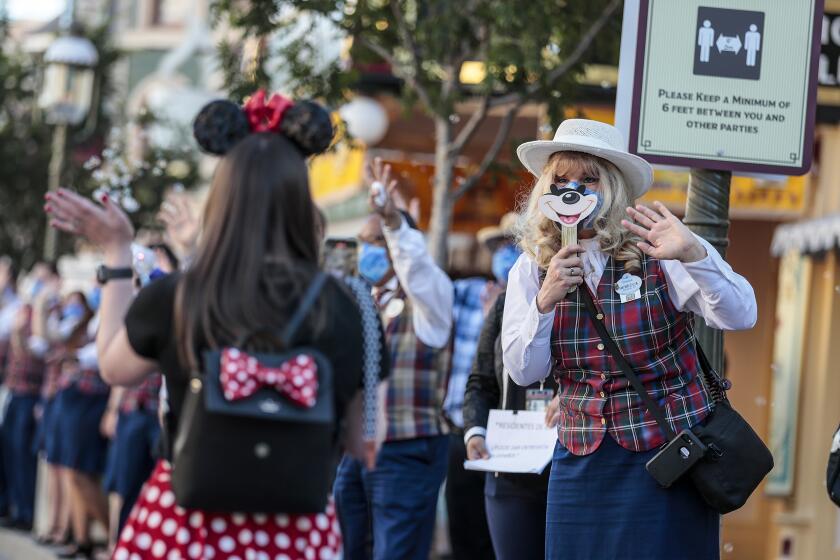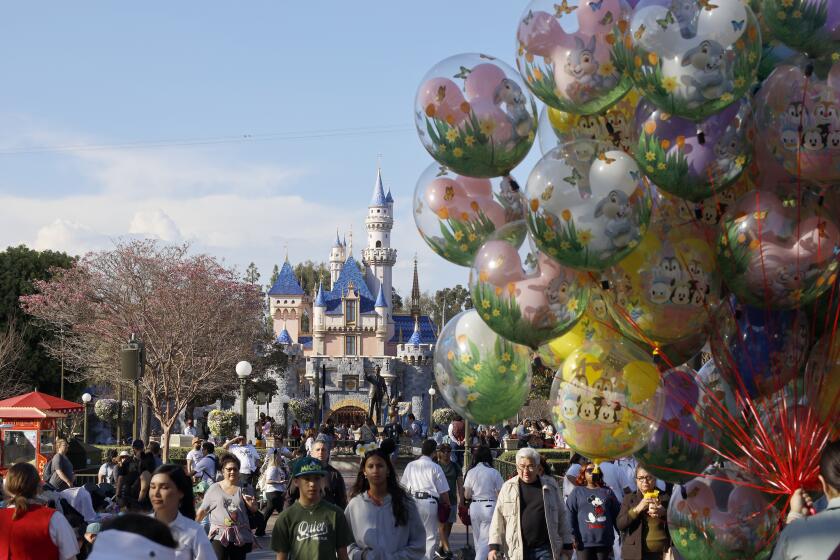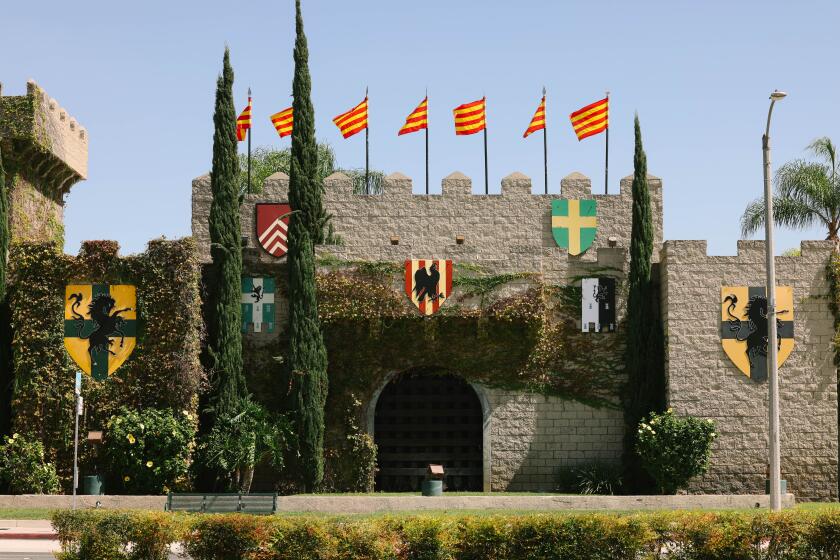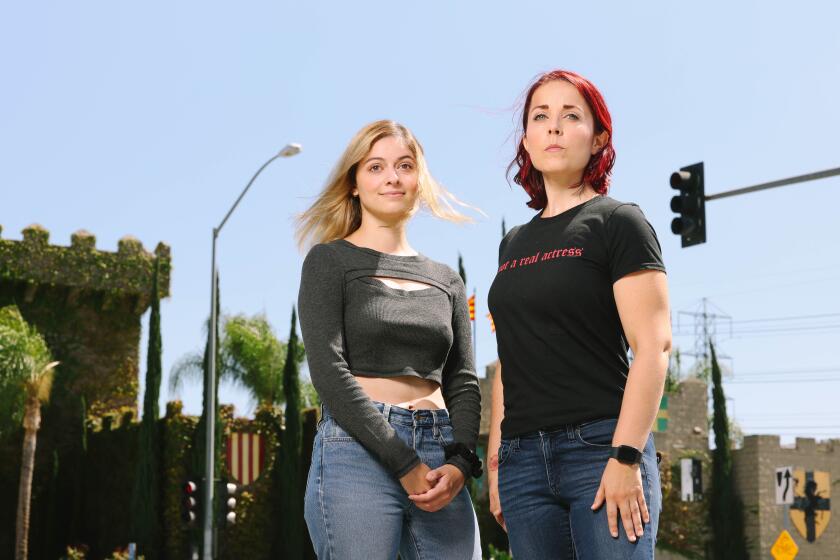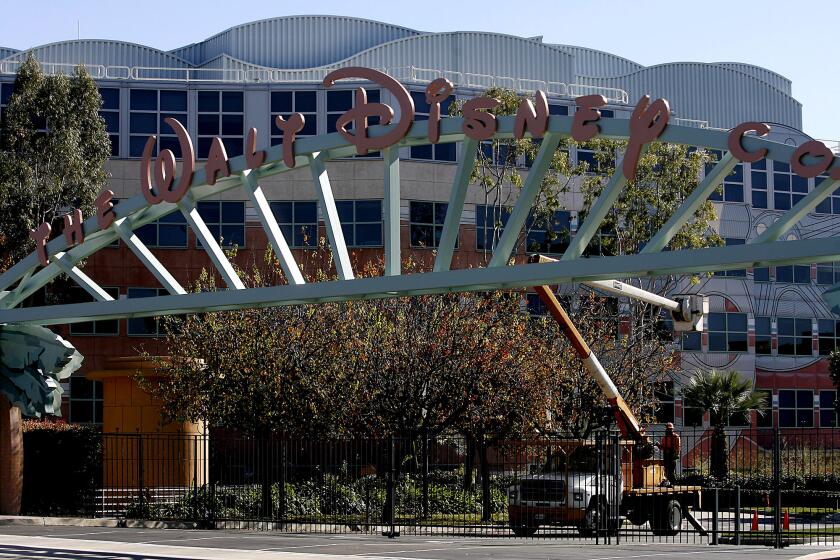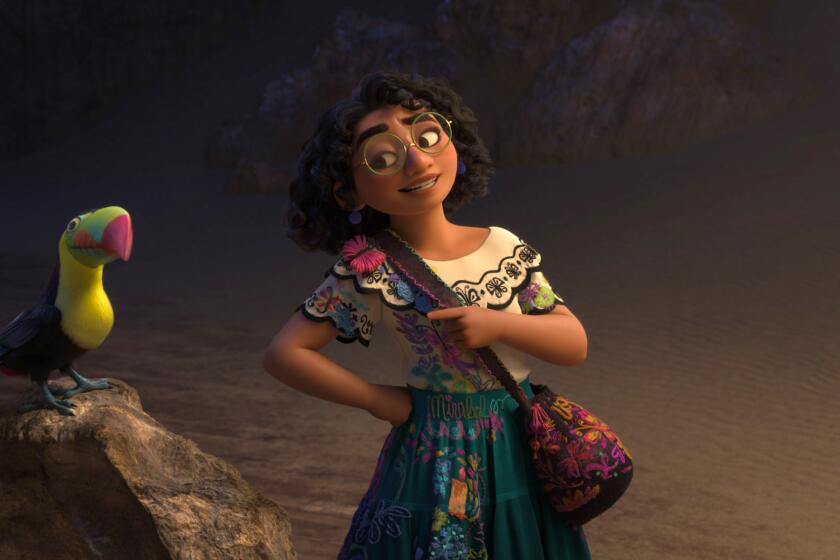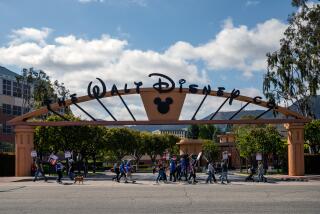‘The fairy dust fades away’: Why the people who play Disneyland’s costumed characters are unionizing
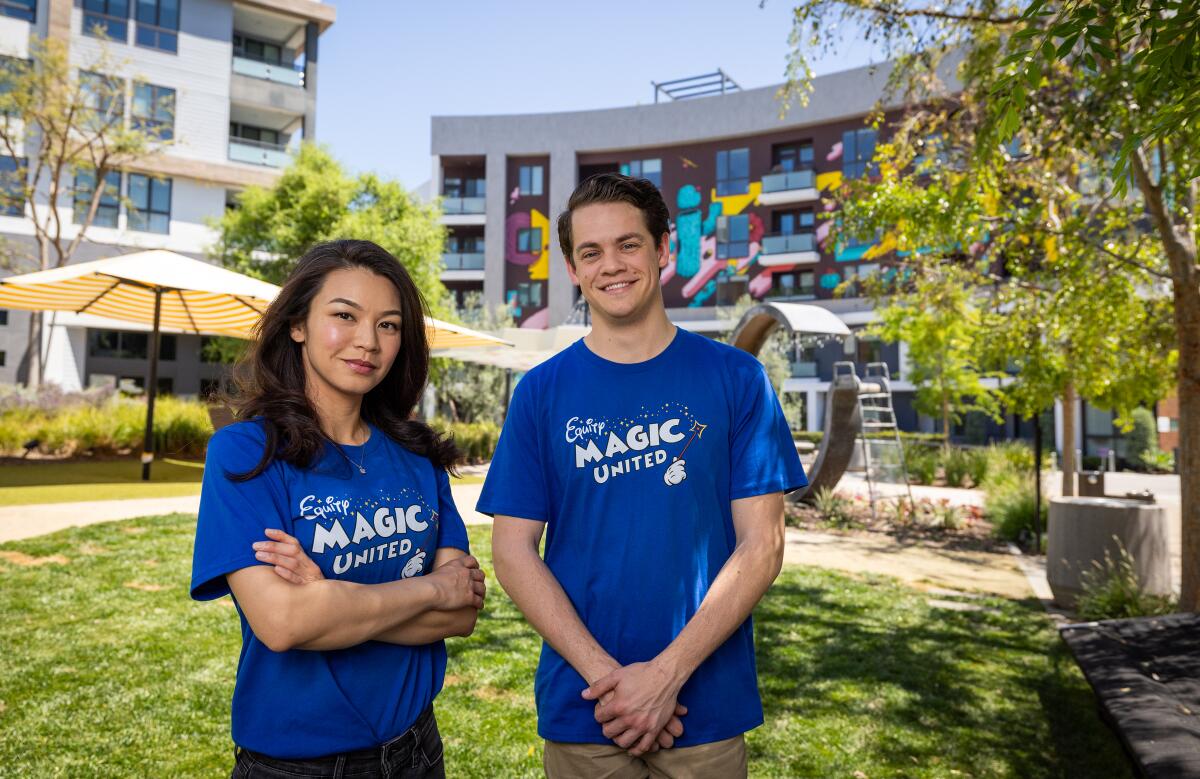
- Share via
Adam Hefner had recently graduated high school and was looking for a job when their sister, who was working in Disneyland Resort’s food and beverage department, alerted them to an opportunity.
The company was searching for a tall “Star Wars” fan to portray a particular character (Hefner declined to say which one) before the opening of Disneyland’s Galaxy’s Edge attraction in 2019.
Getting a role at the park was a dream come true for Hefner, a longtime Southern California resident who lives in Anaheim and grew up with season passes. Several years later, however, Hefner has a less enchanted view.
“After a couple of months ... the fairy dust fades away, and you see your friends and people you really care about hurting and burnt out and not able to pay their rent,” Hefner said. “ Despite it being ‘the Happiest Place on Earth’ ... it’s not always the case for the people that are working there.”
Character performers at Disneyland and Disney California Adventure in Anaheim are moving to unionize under the Actors’ Equity Assn.
Hefner, 28, belongs to Magic United, a bargaining unit of about 1,700 employees in the characters and parades departments at Anaheim’s Disneyland Resort. In addition to the actors who portray characters such as Mickey and Minnie Mouse, Cinderella and Prince Charming in the parks and nearby hotels, Magic United includes hosts, trainers, leads and other workers who support them.
In February, the workers announced their intent to unionize under the Actors’ Equity Assn., which already represents actors, dancers and singers at Walt Disney World Resort in Orlando, Fla.
Magic United filed a petition Wednesday for a union election conducted by the National Labor Relations Board. If a majority of the bargaining unit votes in favor, Magic United will officially join the Actors’ Equity Assn. and begin the process of negotiating its first contract with Disney.

Subscribers get exclusive access to this story
We’re offering L.A. Times subscribers special access to our best journalism. Thank you for your support.
Explore more Subscriber Exclusive content.
“We support our cast members’ right to a confidential vote that recognizes their individual choices,” Disneyland Resort spokesperson Jessica Good said in a statement.
The character and parade performers are trained to keep their roles a secret to avoid spoiling the magic. They are the heroes, villains, fairies, princes, princesses and cartoon characters that wave from parade floats, sign autographs, give high-fives and hugs, pose for photos and entertain hotel and park guests.
As Disneyland marks 50 years, a Times editor recalls how as a youth he played characters there. It now seems more than high jinks and sweat.
“There’s nothing else like” working at Disneyland Resort, said Zach Elefante, a 29-year-old cast member in the parades department who lives in Santa Ana.
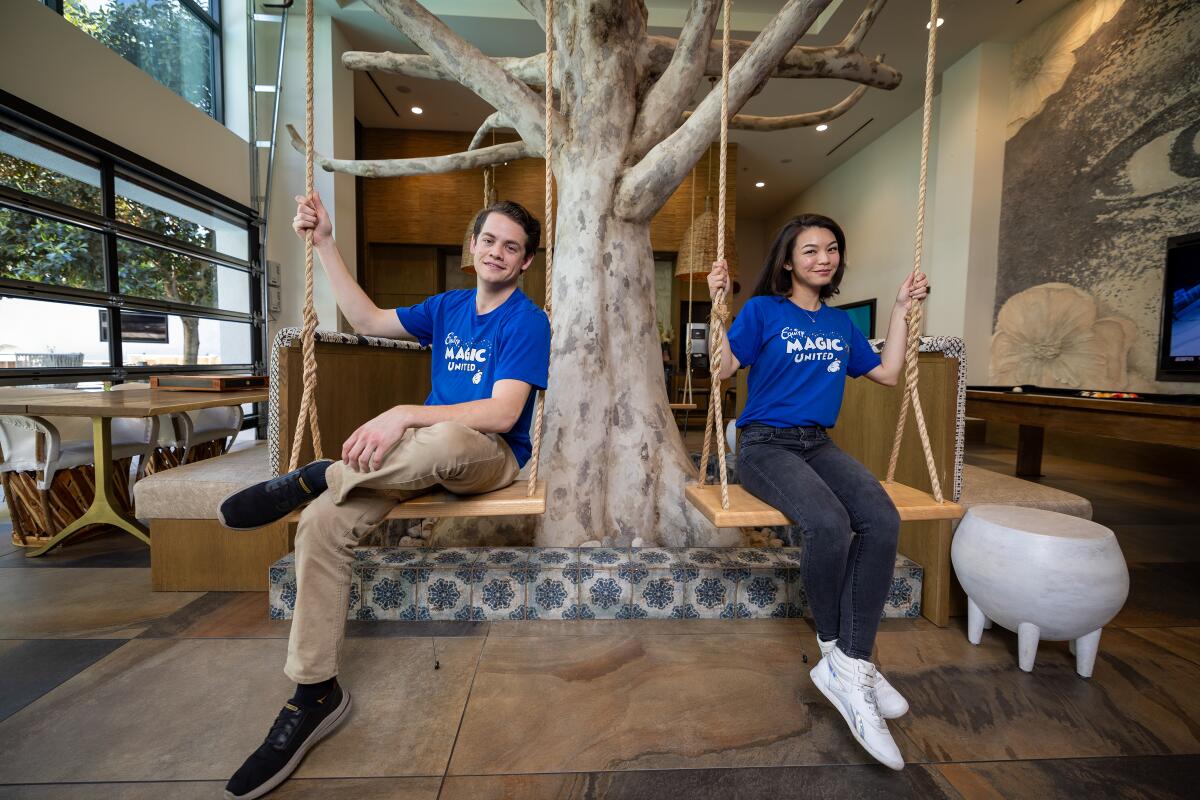
“From young to young at heart, lots of people have such a deep emotional connection to Disney stories and Disney parks,” he said. “You can’t really find that kind of a connection in other places.”
The bargaining unit is seeking improved health and safety standards, flexible paid time off, fair schedules, job security and greater involvement in workplace discussions, as well as higher wages — because, as Actors’ Equity Assn. President Kate Shindle puts it, “magic does not pay the rent.”
The park’s character performers are not alone in their advocacy for better treatment. On Tuesday, a separate Disneyland Resort bargaining unit — made up of custodians, ride operators, candy makers, merchandise clerks and other employees — gathered in Anaheim to launch its 2024 contract campaign ahead of its first round of negotiations next week.
The rise in union activism comes at a pivotal time for Disney, which recently vowed to invest $60 billion into its parks and resorts business over the next decade. The Anaheim City Council early Wednesday unanimously approved a multibillion-dollar Disneyland expansion plan, allowing the theme park to build new attractions, shops and restaurants within its current properties.
Anaheim City Council approves a plan to amend zoning rules to allow Disneyland to build new rides, hotels and stores within its existing footprint.
The unions’ efforts reflect a broader trend toward labor action in myriad industries, including hospitality and entertainment. Last year, Disney’s film and television businesses — along with other Hollywood studios — were hobbled by six months of strikes by screenwriters and actors.
“We’re not considered at all in the decision-making process,” Elefante said. “If the only thing we were fighting for was a voice at the table, that would make this entire movement worth it.”
A top priority for the organizers of Magic United is creating a healthier and safer work environment for character and parade employees, who often endure injury and discomfort due to the physical nature of their jobs, multiple members of the bargaining unit told The Times.
“A large portion of performers at the resort have been injured and continue to be injured every day,” said Hefner, who also works at the resort as a safety lead. “That’s one of the main reasons that we want to form a union.”
A movement to organize a union among show performers and stable hands at Medieval Times’ Buena Park castle is “dead in the water.”
In a statement provided to The Times, Good said that all employees, “whether represented by a collective bargaining agreement or not, have multiple methods to communicate safety concerns,” including conversations with leadership, safety meetings, roundtables and an anonymous hotline.
“Safety always has been and continues to be a top priority for all of our cast,” Good said.
Hefner said first-aid kits and athletic trainers are available backstage to performers seeking treatment in the form of medicine or strength exercises. Performers are expected to stretch and condition daily.
The characters department also employs safety leads who regularly assess performers experiencing pain or discomfort while working. One Magic United activist who was not authorized to speak publicly estimated that a safety lead typically meets with several employees a day who experience extreme discomfort or pain while performing.
Some cases result from interactions with guests, according to the Magic United organizer. Sometimes a child will become overly excited and jump on Winnie the Pooh, for example.
Other incidents are more targeted, the organizer said, citing a recent trend that saw guests attempt to distract performers playing characters with full-body costumes — especially Mickey — and then aggressively move or twist their heads around.
Depending on which manager is on duty, the Magic United member added, those situations are either taken seriously or “brushed under the rug,” with the affected performer expected to go back out for their next shift.
“When a guest assaults another guest, they’re escorted away from the park,” Hefner said. “If a guest assaults a cast member, they should be escorted out of the park.”
The Buena Park castle will be the second Medieval Times location to vote on unionizing. It’s part of a trend of nontraditional performers seeking to organize.
Unruly parkgoers are just part of the problem, unit members said.
Some performers have described the experience of getting into costume as putting their arms through fiberglass, one Magic United member said, adding that upon removal, the workers’ arms are covered in red bumps and marks that resemble hives.
In the parades department, “there are a lot of injuries” caused by intense choreography and cumbersome costumes, Elefante said. He added that inclement weather — from wet conditions to extreme heat — can pose safety risks even when performances are scaled back accordingly.
“Entertainment cast members ... always push through pain and everything else,” said Mai Vo, a 37-year-old cast member in the characters department who lives in Placentia. “It’s kind of how we work.”
Of the 550 parade workers in the bargaining unit, only 12 qualify for health insurance through the company due to show schedules that Elefante said seem to be “designed” to maintain their part-time status.
“Our part-time cast members are hired to work year-round,” Good said in a statement. “While these casts average approximately 20 hours per week, they do work more hours during holidays and peak seasons. When they qualify for full time status, they are eligible for health care benefits.”
Vo was a junior in high school selling bath bombs at a soap shop in Downtown Disney when she was encouraged to audition for a lookalike role at Disneyland Resort. Lookalike characters are played by actors whose faces are exposed while performing, such as heroes, princes and princesses, including Tiana, Rapunzel, Elsa and Mulan.
Vo landed the part when she was 17.
“I remember feeling excited,” Vo said. “But it wasn’t a dream job of mine. It was just something somebody told me to do, and I figured why not? ... I guess, in a way, the Disney life chose me.”
Walt Disney Pictures visual effects workers voted to unionize under IATSE, which the union’s international president said ‘represents a seismic shift in this critical moment in our industry.’
When Vo was hired in 2004, lookalike performers were paid a base rate of $13.50 per hour, she said. The base rate for character and parade performers rose to $24.15 per hour from $20 per hour this year, according to Disneyland officials. Hourly nonunion workers at the resort typically receive annual pay raises in January.
On top of ongoing concerns about pay and working conditions, multiple character and parade workers identified key turning points that influenced their decision to unionize.
One such moment for Vo occurred when employees in the characters department were informed that they would be required to resume physical contact with guests for the first time since the parks shut down due to the COVID-19 pandemic.
For about a year after the parks reopened, meet-and-greet performers interacted and posed for photos with guests from a distance. Vo said she and her colleagues were given about three weeks’ notice before returning to hugging and autograph signing.
“We were told that if we didn’t like it, we could either quit or move to a different department,” Vo said.
Production workers at Walt Disney Animation Studios have voted to unionize under IATSE Local 839, the Animation Guild announced Wednesday.
Shindle of Actors’ Equity Assn. said she finds it surprising that Disney has not voluntarily recognized Magic United yet as a union, considering that the company is looking to invest so much in the parks in the coming years.
“I’m all for great new rides,” Shindle said. “But at a certain point, you also have to take care of the people.”
Times staff writer Andrea Chang contributed to this report.
More to Read
Inside the business of entertainment
The Wide Shot brings you news, analysis and insights on everything from streaming wars to production — and what it all means for the future.
You may occasionally receive promotional content from the Los Angeles Times.
